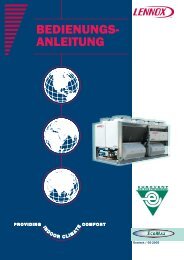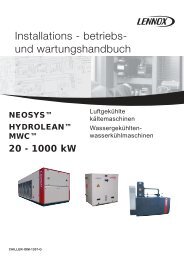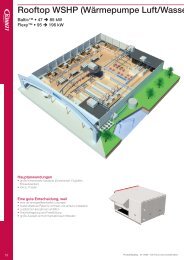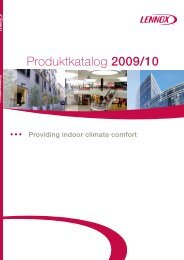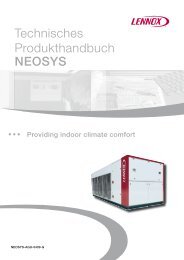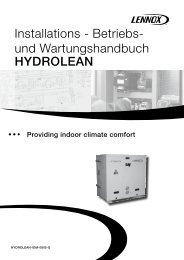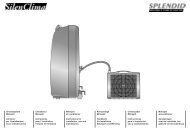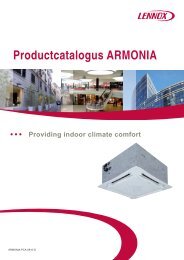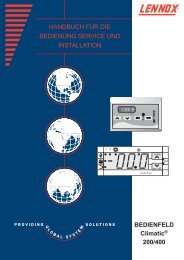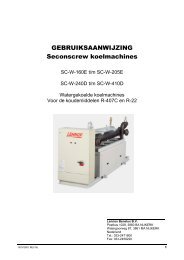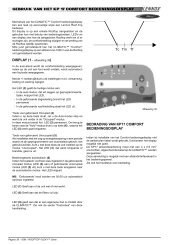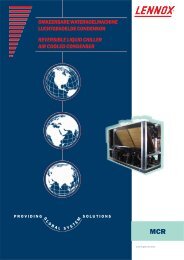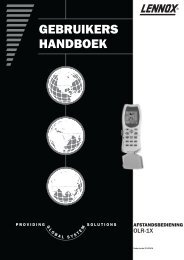LGA/LCA/LHA - lennox
LGA/LCA/LHA - lennox
LGA/LCA/LHA - lennox
Create successful ePaper yourself
Turn your PDF publications into a flip-book with our unique Google optimized e-Paper software.
3−Burner Assembly (Figure 22)<br />
The burners are controlled by the spark electrode, flame sensing<br />
electrode, gas valve and combustion air inducer. The spark<br />
electrode, flame sensing electrode and gas valve are directly<br />
controlled by ignition control. Ignition control and combustion<br />
air inducer is controlled by main control panel A55.<br />
Burners<br />
All units use inshot burners (see figures 22 and 23). Burners<br />
are factory set and do not require adjustment. A peep<br />
hole with cover is furnished in the heating access<br />
panel for flame viewing. Always operate the unit with<br />
the access panel in place.<br />
Burners can be removed individually for service.<br />
Burner maintenance and service is detailed in the<br />
SERVICE CHECKS sections of this manual.<br />
TYPICAL GAS BURNER ASSEMBLY<br />
BURN-<br />
ERS<br />
BURNER<br />
SUPPORT<br />
ORIFICE<br />
SENSOR<br />
BURNER<br />
SUPPORT<br />
CAP<br />
FIGURE 22<br />
Orifice<br />
Each burner uses an orifice which is precisely matched to<br />
the burner input. The orifice is threaded into the burner<br />
manifold. The burner is supported by the orifice and will<br />
easily slide off for service.<br />
NOTE−Do not use thread sealing compound on the orifices.<br />
Using thread sealing compound may plug the orifices.<br />
Each orifice and burner are sized specifically to the unit.<br />
Refer to Lennox Repair Parts Listing for correct sizing information.<br />
TYPICAL GAS MANIFOLD ASSEMBLY<br />
ORIFICE<br />
MANIFOLD<br />
FIGURE 23<br />
BURNERS<br />
Page 50<br />
NOTE−In primary and secondary high temperature limits<br />
S10, S99, S21, and S100 the ignition circuits in both gas<br />
heat sections one and two are immediately de−energized<br />
when terminals 1−3 open and the indoor blower motor<br />
is immediately energized when terminals 1−2<br />
close. This is the primary and secondary safety shut−<br />
down function of the unit.<br />
4−Primary High Temperature Limits<br />
S10 & S99<br />
S10 is the primary high temperature limit for gas heat section<br />
one, while S99 is the primary high temperature limit for gas<br />
heat section two. S10 is located in the blower compartment<br />
and is mounted on the end of the blower support panel which<br />
divides the blower compartment from the heating compartment<br />
(see figure 17). S99 is located on the blower support<br />
panel which separates the second gas heat section from the<br />
outdoor condenser section (see figure 17).<br />
Figure 17 also shows the location of S10 and S99 in<br />
<strong>LGA</strong>240H units. S10 and S99 are located on the drip shield<br />
behind the blower housing. In this location S10 and S99<br />
serve as both primary and secondary limt.<br />
Primary limit S10 is wired to the main control panel A55<br />
which energizes burner 1 control (A3), while primary limit S99<br />
is wired to the gas 2 panel A58 which energizes burner 2<br />
control (A12). Its N.C. contacts open to de−energize the<br />
ignition control when excessive temperature is reached in the<br />
blower compartment. At the same time, the N.O. contacts of<br />
S10 and S99 close energizing the blower relay coil K3 through<br />
control A55. If either limit trips the blower will be energized.<br />
Limit set points are factory set and cannot be adjusted. If limit<br />
must be replaced same type and set point must be used. See<br />
Lennox Repair Parts Handbook .<br />
5−Secondary High Temperature Limits<br />
S21 & S100<br />
S21 is the secondary high temperature limit for heat section<br />
one, while S100 is the secondary high temperature<br />
limit for heat section two. Like the primary limits, the secondary<br />
limits are located in the blower compartment.<br />
S21 and S100 are mounted on top of the blowers (see<br />
figure 17).<br />
Secondary limit S21 is also wired to the main control<br />
panel A55, while secondary limit S100 is wired to the gas<br />
2 panel A58. The secondary limits function in the same<br />
manner as the primary limits, but are factory set to actuate<br />
at different temperatures. The N.O. contacts of both<br />
S21 and S100 are connected to the blower relay coil K3<br />
through control A55. If either limit trips the blower will be<br />
energized. All limits used are SPDT N.C. auto−reset limits.<br />
Limit set points are factory set and cannot be adjusted. If limit<br />
must be replaced same type and set point must be used. See<br />
Lennox Repair Parts Handbook .



